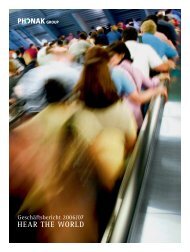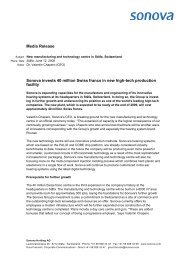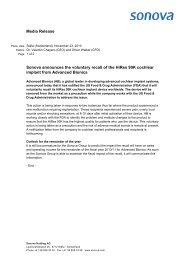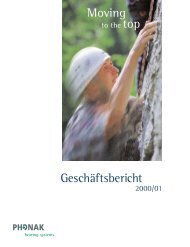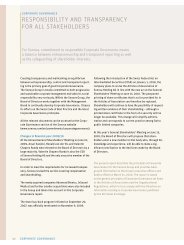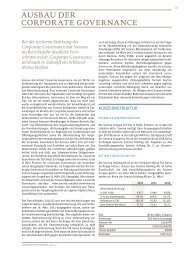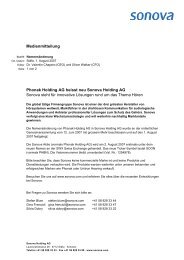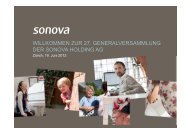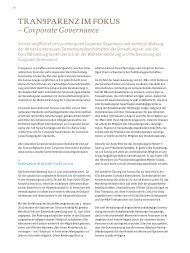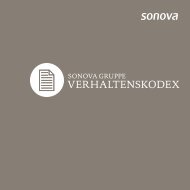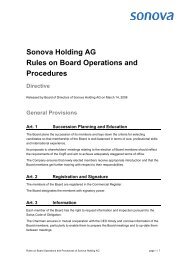Annual Report 2010/11 - Sonova
Annual Report 2010/11 - Sonova
Annual Report 2010/11 - Sonova
You also want an ePaper? Increase the reach of your titles
YUMPU automatically turns print PDFs into web optimized ePapers that Google loves.
ISO 9001:2000 and 13485:2003 certification. In June <strong>2010</strong>,<br />
the Group's headquarters in Stäfa, Switzerland, was certified<br />
to meet the ISO 14001:2004 environmental management<br />
standard that ensures the environmental impact of products<br />
and processes is minimized over the long run.<br />
All of <strong>Sonova</strong>’s products are subject to the safety guidelines<br />
set down in the European Medical Devices Directive (MDD).<br />
<strong>Sonova</strong>’s hearing systems are compliant with EU Directive<br />
MDD 93/42/EEC and ISO standards 9001:2008 and<br />
13485:2003. As a result, <strong>Sonova</strong> is not allowed to use any<br />
raw materials or substances classified as hazardous in its<br />
production process; this directive also imposes restrictions<br />
on the use of recycled or used components.<br />
Supplementary technical certifications required by the EU<br />
Radio & Telecommunications Terminal Equipment Directive<br />
R&TTE 99/5/EU guarantee that end-users are protected<br />
when using analog or digital wireless technology. <strong>Sonova</strong><br />
ensures biocompatibility in the use of the medical products<br />
it manufactures to meet the EN ISO 10993-1:2003 standard.<br />
In the US, hearing systems are classified as Category I<br />
medical products that can be launched on the market<br />
without pre-market and FDA approval with an exemption<br />
in accordance with 510(k). The FDA recommends labeling<br />
on packaging for wireless connection technologies that<br />
indicates the potential for electromagnetic interference.<br />
The FDA is currently assessing whether wireless solutions<br />
should be tested for electromagnetic compatibility before<br />
they are approved for the US market.<br />
The Lyric hearing system was cleared for market introduction<br />
by the US Food and Drug Administration (FDA) in<br />
the 510(k) approval process (permit number: K08<strong>11</strong>36) in<br />
2008. As a medical device, Lyric is manufactured with<br />
materials and processes that comply with the FDA Quality<br />
System Regulation 21 CFR § 820. InSound Medical has<br />
also been ISO 13485 certified since 2007, meaning it also<br />
satisfies international requirements as a medical device<br />
manufacturer. The systems for the US market have been manufactured<br />
thus far in the United States. Starting June 20<strong>11</strong>,<br />
Lyric is scheduled to be manufactured and dispatched primarily<br />
from <strong>Sonova</strong>'s Vietnamese Operation Center.<br />
The cochlear implant and the respective accessories from the<br />
Advanced Bionics brand are classified as active implantable<br />
medical products which are regulated by the EU Directive<br />
AIMDD 90/385/EEC and require approval in most<br />
SUSTAINABILITY<br />
markets. In the US, the HiRes 90K cochlear implant and<br />
the corresponding accessories were approved via a premarket<br />
approval supplement (PMA-S). The systems were<br />
introduced to all other markets following this assessment.<br />
The HiRes 90K cochlear implant was voluntarily recalled<br />
in November <strong>2010</strong>. This was a precautionary measure<br />
based on two instances in which the product was removed<br />
for safety reasons due to an extremely rare malfunction.<br />
Advanced Bionics received CE certification from the European<br />
notified body TÜV for changes to the manufacturing<br />
process of the CI HiRes 90K and approval to resume distribution<br />
of the implant in European markets in April 20<strong>11</strong>.<br />
The implant will be reintroduced on the US market following<br />
pending approval from the FDA.<br />
ENVIRONMENT<br />
SUSTAINABLE ENVIRONMENTAL MANAGEMENT<br />
<strong>Sonova</strong> is actively engaged in the protection of the environment<br />
and pursues the aim of preserving and promoting<br />
the safety and cleanliness of working and living areas at<br />
Group level. Sustainable business practices in the Group<br />
are based on the efficient use of natural resources, preventive<br />
measures to reduce environmental damage from<br />
products and processes, minimizing waste, and the safe<br />
and responsible disposal of residual waste.<br />
The large majority of the materials <strong>Sonova</strong> uses to manufacture<br />
its hearing systems are environmentally friendly.<br />
Compared to other medical devices, the production of hearing<br />
systems uses fewer materials and less energy – the same<br />
applies to the environmental impact of processes and products.<br />
<strong>Sonova</strong> also constantly endeavors to further reduce<br />
its environmental impact.<br />
Environmental standards implemented Group-wide include:<br />
Ban on CFCs<br />
Since 1992, Phonak has avoided using chlorofluorocarbons,<br />
which damage the ozone layer, in its production processes<br />
across the Group.<br />
RoHS compliance<br />
The EU directive RoHS 2002/95/EC (Restriction of Hazardous<br />
Substances) was implemented Group-wide back in 2006<br />
39



